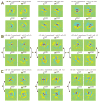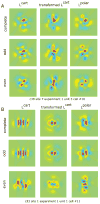Contextual modulation of V1 receptive fields depends on their spatial symmetry
- PMID: 18679785
- PMCID: PMC2651997
- DOI: 10.1007/s10827-008-0107-5
Contextual modulation of V1 receptive fields depends on their spatial symmetry
Abstract
The apparent receptive field characteristics of sensory neurons depend on the statistics of the stimulus ensemble--a nonlinear phenomenon often called contextual modulation. Since visual cortical receptive fields determined from simple stimuli typically do not predict responses to complex stimuli, understanding contextual modulation is crucial to understanding responses to natural scenes. To analyze contextual modulation, we examined how apparent receptive fields differ for two stimulus ensembles that are matched in first- and second-order statistics, but differ in their feature content: one ensemble is enriched in elongated contours. To identify systematic trends across the neural population, we used a multidimensional scaling method, the Procrustes transformation. We found that contextual modulation of receptive field components increases with their spatial extent. More surprisingly, we also found that odd-symmetric components change systematically, but even-symmetric components do not. This symmetry dependence suggests that contextual modulation is driven by oriented On/Off dyads, i.e., modulation of the strength of intracortically-generated signals.
Figures







Similar articles
-
Contextual modulation of sensitivity to naturalistic image structure in macaque V2.J Neurophysiol. 2018 Aug 1;120(2):409-420. doi: 10.1152/jn.00900.2017. Epub 2018 Apr 11. J Neurophysiol. 2018. PMID: 29641304 Free PMC article.
-
Receptive-field maps of correlated discharge between pairs of neurons in the cat's visual cortex.J Neurophysiol. 1994 Jan;71(1):330-46. doi: 10.1152/jn.1994.71.1.330. J Neurophysiol. 1994. PMID: 8158235
-
Spatial structure and symmetry of simple-cell receptive fields in macaque primary visual cortex.J Neurophysiol. 2002 Jul;88(1):455-63. doi: 10.1152/jn.2002.88.1.455. J Neurophysiol. 2002. PMID: 12091567
-
Surround suppression supports second-order feature encoding by macaque V1 and V2 neurons.Vision Res. 2014 Nov;104:24-35. doi: 10.1016/j.visres.2014.10.004. Epub 2014 Oct 23. Vision Res. 2014. PMID: 25449336 Free PMC article. Review.
-
Contribution of feedforward, lateral and feedback connections to the classical receptive field center and extra-classical receptive field surround of primate V1 neurons.Prog Brain Res. 2006;154:93-120. doi: 10.1016/S0079-6123(06)54005-1. Prog Brain Res. 2006. PMID: 17010705 Review.
Cited by
-
Analyzing multicomponent receptive fields from neural responses to natural stimuli.Network. 2011;22(1-4):45-73. doi: 10.3109/0954898X.2011.566303. Epub 2011 Jul 22. Network. 2011. PMID: 21780916 Free PMC article. Review.
-
Reliable, Fast and Stable Contrast Response Function Estimation.Vision (Basel). 2022 Oct 17;6(4):62. doi: 10.3390/vision6040062. Vision (Basel). 2022. PMID: 36278674 Free PMC article.
-
Stability of simple/complex classification with contrast and extraclassical receptive field modulation in macaque V1.J Neurophysiol. 2013 Apr;109(7):1793-803. doi: 10.1152/jn.00997.2012. Epub 2013 Jan 9. J Neurophysiol. 2013. PMID: 23303859 Free PMC article.
-
Local non-linear interactions in the visual cortex may reflect global decorrelation.J Comput Neurosci. 2011 Feb;30(1):109-24. doi: 10.1007/s10827-010-0239-2. Epub 2010 Apr 27. J Comput Neurosci. 2011. PMID: 20422445
-
Link between orientation and retinotopic maps in primary visual cortex.Proc Natl Acad Sci U S A. 2012 May 1;109(18):7091-6. doi: 10.1073/pnas.1118926109. Epub 2012 Apr 16. Proc Natl Acad Sci U S A. 2012. PMID: 22509015 Free PMC article.
References
Publication types
MeSH terms
Grants and funding
LinkOut - more resources
Full Text Sources

